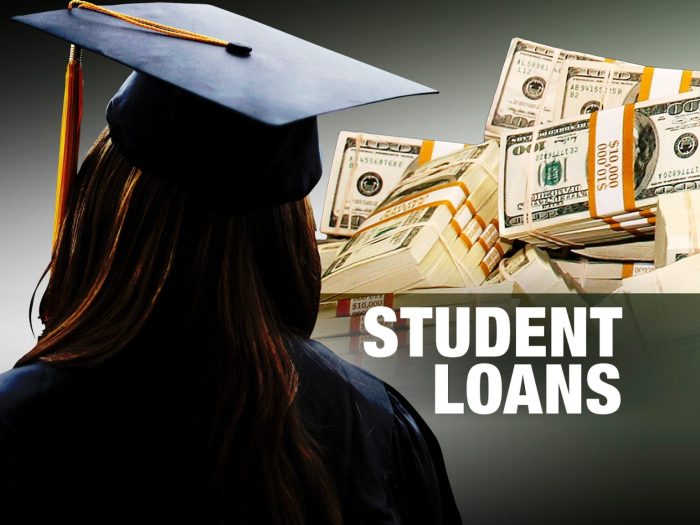
The crushing weight of student loan debt is a reality for millions. The persistent question, “How fast can I pay off student loans?”, echoes in the minds of many recent graduates and seasoned professionals alike. This journey towards financial freedom isn’t solely about numbers; it’s a strategic blend of understanding your debt, employing effective repayment strategies, and making conscious financial choices. This guide navigates the complexities of student loan repayment, empowering you to accelerate your path to a debt-free future.
We’ll explore various repayment methods, from the avalanche and snowball techniques to the potential benefits of refinancing. We’ll also delve into practical strategies for boosting your income and cutting expenses, providing actionable steps to significantly reduce your loan repayment timeline. Finally, we’ll discuss the importance of seeking professional financial advice when needed, ensuring you have the support and guidance to make informed decisions.
Understanding Your Student Loan Debt
Paying off student loans quickly requires a clear understanding of your debt. This involves identifying the types of loans you have, their interest rates, and how those rates affect your repayment timeline. Understanding these factors will empower you to make informed decisions about your repayment strategy.
Types of Student Loans and Interest Rates
Student loans are broadly categorized as federal and private loans. Federal loans are offered by the U.S. government and generally offer more favorable terms, including various repayment plans and protections against default. Private loans, on the other hand, are provided by banks and other financial institutions. Their terms and interest rates are typically less favorable and vary significantly depending on the lender and your creditworthiness. Federal loans usually have fixed interest rates, while private loan rates can be fixed or variable. Interest rates for both types of loans fluctuate depending on market conditions and the loan’s terms. For example, a federal subsidized loan might have a fixed interest rate of 5%, while a private loan might have a variable rate starting at 7%, potentially increasing over time.
Interest Capitalization and its Impact on Repayment
Interest capitalization occurs when accumulated interest on your loan is added to your principal balance. This increases the total amount you owe, ultimately lengthening your repayment period and increasing the total interest paid. For example, if you have a loan with $10,000 in principal and $1,000 in accrued interest, capitalization adds the $1,000 to the principal, resulting in a new principal balance of $11,000. Future interest calculations are then based on this higher amount. Understanding when capitalization occurs for your loans is crucial for minimizing its negative impact on your repayment speed.
Obtaining a Complete Overview of Your Student Loan Debt
Gathering all the necessary information about your student loans is the first step towards effective repayment. Follow these steps to create a comprehensive overview:
- Access your federal student aid account: Log in to the National Student Loan Data System (NSLDS) website to view all your federal student loans. This will provide details on loan amounts, interest rates, and repayment plans.
- Review your private loan statements: Gather statements or login information for any private student loans. This will provide details about loan amounts, interest rates, and repayment schedules.
- Consolidate your information: Create a spreadsheet or use a budgeting app to consolidate all your loan information into a single, easily accessible document. This will allow you to compare loans side-by-side and develop a comprehensive repayment strategy.
Comparison of Different Loan Repayment Plans
Several repayment plans are available, each with different implications for monthly payments, total interest paid, and loan payoff time. The optimal plan depends on your individual financial circumstances. The following table provides a general comparison. Note that actual figures will vary based on loan amounts, interest rates, and individual circumstances. These are illustrative examples only and should not be considered financial advice.
| Repayment Plan | Monthly Payment (Example) | Total Interest Paid (Example) | Loan Payoff Time (Example) |
|---|---|---|---|
| Standard Repayment | $300 | $5,000 | 10 years |
| Extended Repayment | $200 | $8,000 | 25 years |
| Income-Driven Repayment (IBR) | $150 | $10,000+ | 20-25 years |
Exploring Accelerated Repayment Strategies

Accelerating your student loan repayment requires a strategic approach. Understanding different repayment methods and their implications can significantly impact how quickly you become debt-free. This section explores various strategies, including refinancing options, to help you design a personalized plan for faster repayment.
Debt Repayment Methods: Avalanche and Snowball
Choosing the right repayment method is crucial for efficient debt reduction. Two popular approaches are the avalanche and snowball methods. Both involve making more than the minimum payment, but they differ in their prioritization.
- Avalanche Method: This method prioritizes paying off the loan with the highest interest rate first. By tackling high-interest debts aggressively, you save money on interest in the long run, leading to faster overall repayment. For example, if you have a loan with 7% interest and another with 4%, the avalanche method focuses on the 7% loan first.
- Snowball Method: This method prioritizes paying off the loan with the smallest balance first, regardless of the interest rate. The psychological benefit of quickly eliminating a loan can motivate borrowers to continue with the repayment plan. The snowball method might feel more rewarding initially, but it may take longer to pay off the total debt compared to the avalanche method. For example, if you have a loan with a $1,000 balance and another with a $5,000 balance, the snowball method would tackle the $1,000 loan first.
Pros and Cons of Repayment Methods
The avalanche and snowball methods each have advantages and disadvantages that should be considered based on individual circumstances and financial goals.
| Method | Pros | Cons |
|---|---|---|
| Avalanche | Saves money on interest in the long run; faster overall debt payoff. | Can be demotivating initially if the highest-interest loan has a large balance. |
| Snowball | Provides early psychological wins, increasing motivation; easier to start. | May take longer to pay off total debt and cost more in interest. |
Refinancing Student Loans
Refinancing your student loans involves replacing your existing loans with a new loan from a different lender, often at a lower interest rate. This can significantly reduce the overall cost of your loans and shorten your repayment timeline. However, it’s essential to carefully compare offers and understand the terms and conditions before refinancing. Factors like your credit score and income will impact the interest rate you qualify for. A lower interest rate translates to lower monthly payments and faster debt repayment. For instance, refinancing from a 7% interest rate to a 4% interest rate could save thousands of dollars in interest over the life of the loan.
Sample Budget for Accelerated Loan Repayment
Creating a detailed budget is crucial for successful accelerated repayment. This example illustrates a possible allocation of funds. Remember to adjust it based on your individual income and expenses.
| Income | Amount | Expenses | Amount |
|---|---|---|---|
| Monthly Salary | $3,000 | Rent/Mortgage | $1,000 |
| Utilities | $200 | ||
| Groceries | $300 | ||
| Transportation | $150 | ||
| Other Expenses | $250 | ||
| Total Expenses | $1,900 | ||
| Amount Available for Loan Repayment | $1,100 |
Increasing Your Income and Reducing Expenses
Accelerating your student loan repayment requires a multifaceted approach. A crucial element involves strategically managing both your income and expenses. By increasing your income streams and simultaneously reducing unnecessary spending, you can free up significant funds to dedicate towards your loan principal. This section will explore practical strategies to achieve this balance.
Potential Avenues for Increasing Income
Boosting your income can significantly accelerate your loan repayment. Several avenues exist, ranging from supplemental part-time work to leveraging your existing skills for additional income. Careful consideration of your skills, available time, and desired effort level will help you select the most suitable option.
- Part-Time Jobs: Consider part-time employment in fields complementary to your skills or interests. This could involve roles like tutoring, freelance writing, or customer service positions, offering flexible hours to accommodate your existing commitments.
- Side Hustles: The gig economy offers numerous opportunities. Platforms like Upwork and Fiverr connect freelancers with clients needing various services, from graphic design to web development. Driving for ride-sharing services or delivering food are also readily available options.
- Salary Negotiation: If you’re employed, research industry salary benchmarks and confidently negotiate for a higher salary or a bonus. A modest increase in your annual salary can translate to substantial extra funds for loan repayment over time.
Practical Strategies for Reducing Monthly Expenses
Reducing unnecessary expenses is just as crucial as increasing income. A thorough review of your spending habits can reveal areas where you can make significant savings without compromising your quality of life.
- Identify Non-Essential Spending: Analyze your bank statements and credit card bills to pinpoint recurring expenses that can be reduced or eliminated. This could include dining out, entertainment subscriptions, or impulse purchases.
- Budget for Necessities: Create a realistic budget that allocates funds for essential expenses like housing, food, transportation, and utilities. This ensures you meet your basic needs while remaining financially responsible.
- Negotiate Bills: Contact your service providers (internet, phone, insurance) to negotiate lower rates or explore alternative, more affordable options. Many companies are willing to offer discounts to retain customers.
Tracking Income and Expenses Using Budgeting Tools
Effectively managing your finances requires meticulous tracking of both income and expenses. Budgeting apps and spreadsheets offer convenient tools to monitor your financial health.
Budgeting apps often provide features like automated transaction categorization, spending visualizations, and goal-setting tools. Examples include Mint, Personal Capital, and YNAB (You Need A Budget). Spreadsheets offer a more hands-on approach, allowing for customized tracking and analysis. Using either method, regularly review your progress to identify areas for improvement and ensure you stay on track.
Resources for Finding Additional Income and Budgeting Tools
Numerous resources are available to assist in finding additional income opportunities and managing your budget effectively.
- Websites for Side Hustles: Upwork, Fiverr, TaskRabbit, Instacart, DoorDash.
- Budgeting Apps: Mint, Personal Capital, YNAB (You Need A Budget), EveryDollar.
- Financial Literacy Websites: The Consumer Financial Protection Bureau (CFPB) website offers valuable resources on budgeting, debt management, and financial planning.
Seeking Professional Financial Advice

Navigating the complexities of student loan repayment can be overwhelming. A personalized approach, tailored to your specific financial situation and goals, is often the most effective strategy. Seeking professional financial advice can provide the structure and support needed to create a manageable and efficient repayment plan.
A financial advisor plays a crucial role in developing a personalized student loan repayment plan by analyzing your complete financial picture. This includes assessing your income, expenses, assets, and liabilities, not just your student loan debt. They will then help you develop a strategy that aligns with your broader financial goals, such as saving for a down payment on a house, retirement planning, or building an emergency fund. This holistic approach ensures your student loan repayment plan doesn’t compromise other essential financial objectives.
Benefits of Professional Financial Guidance for Student Loan Debt
Professional guidance offers several significant benefits. A financial advisor can provide objective analysis, helping you avoid emotional decision-making often associated with debt. They can also identify potential overlooked opportunities for savings or income increases that can be directly applied to loan repayment. Furthermore, they can negotiate with lenders on your behalf, potentially securing better repayment terms or reducing interest rates. Finally, a structured plan provides accountability and reduces the likelihood of falling behind on payments.
Comparison of Financial Professionals’ Services
Credit counselors and financial advisors offer distinct services. Credit counselors primarily focus on budgeting, debt management, and negotiating with creditors to reduce interest rates or consolidate debt. They often work with individuals facing significant financial hardship. Financial advisors, on the other hand, take a broader perspective, offering comprehensive financial planning services that include investment management, retirement planning, tax optimization, and estate planning, in addition to debt management strategies. The choice depends on your specific needs and the complexity of your financial situation. If you’re struggling to manage your budget and make minimum payments, a credit counselor might be sufficient. However, if you require a holistic financial plan encompassing various aspects of your financial life, a financial advisor is the more appropriate choice.
Questions to Ask a Potential Financial Advisor
Before engaging a financial advisor, it’s essential to gather information and ensure they’re the right fit for your needs. A structured approach to this process minimizes the risk of selecting an advisor who doesn’t align with your goals.
- What is your experience with student loan debt management?
- What fees do you charge, and how are they structured?
- What is your approach to developing a personalized repayment plan?
- Can you provide examples of successful student loan repayment strategies you’ve implemented for previous clients?
- What is your professional certification or designation (e.g., CFP, CFA)?
- What is your approach to dealing with unexpected financial setbacks?
- What is your communication style and how frequently will you provide updates?
- Can you provide references from previous clients?
Visualizing Your Progress and Maintaining Motivation
Paying off student loans can feel like a marathon, not a sprint. Maintaining momentum requires more than just a repayment plan; it demands a strategic approach to visualization, motivation, and consistent tracking. By actively visualizing your progress and celebrating milestones, you can significantly increase your chances of successfully achieving your debt-free goal.
Visualizing your progress is crucial for maintaining motivation throughout the often lengthy repayment process. Seeing tangible evidence of your hard work fuels perseverance and provides a sense of accomplishment, even during challenging periods. This positive reinforcement counteracts the potential for discouragement and reinforces the commitment to your financial goals.
Motivational Strategies for Consistent Repayment
Consistent repayment requires a multifaceted approach. Several strategies can help maintain motivation and prevent setbacks. Creating a visual representation of your debt, such as a debt snowball or debt avalanche chart, provides a tangible reminder of your progress. Regularly reviewing this chart can boost morale and highlight the positive impact of your consistent payments. Additionally, setting small, achievable goals along the way, such as paying off one loan entirely or reaching a specific debt reduction milestone, can provide a sense of accomplishment and encourage continued effort. Rewarding yourself for reaching these milestones, within reason, can also serve as a powerful motivator. For example, after paying off one loan, you might treat yourself to a weekend getaway or a small purchase you’ve been wanting.
Tracking Progress and Celebrating Milestones
Tracking your progress is paramount to staying motivated and ensuring you’re on track to meet your financial goals. Several methods can help you effectively monitor your repayment journey. Dedicated budgeting apps can automatically track your payments and provide visual representations of your progress. Alternatively, a simple spreadsheet can be used to manually track payments, interest accrued, and the remaining balance. Regularly reviewing your progress, whether weekly, monthly, or quarterly, allows you to celebrate milestones and adjust your strategy if needed. Celebrating these achievements, no matter how small, is vital for maintaining morale and reinforcing positive behavior. For instance, reaching a halfway point could warrant a celebratory dinner, while paying off a significant portion of your debt might justify a more substantial reward.
The Emotional Impact of Successfully Paying Off Student Loans
The feeling of finally paying off student loans is incredibly liberating. Imagine the weight lifted from your shoulders, the sense of accomplishment washing over you, and the newfound financial freedom at your disposal. It’s a moment of immense pride, a testament to your dedication, discipline, and perseverance. After years of meticulous planning, consistent payments, and sacrifices, you’ve conquered a significant financial hurdle. This achievement opens doors to new opportunities, from saving for a down payment on a house to investing in your future or simply enjoying a well-deserved break. The emotional impact transcends the mere financial aspect; it’s a powerful affirmation of your ability to overcome challenges and achieve long-term goals. The sense of relief, accomplishment, and newfound confidence is a deeply rewarding experience. This freedom allows for greater financial flexibility, enabling you to pursue personal and professional aspirations without the constant pressure of student loan debt.
Closure

Successfully navigating the path to student loan repayment requires a multifaceted approach. By understanding your loan details, implementing strategic repayment strategies, optimizing your finances, and seeking professional guidance when necessary, you can significantly accelerate your progress. Remember, the journey may be challenging, but the sense of accomplishment and financial freedom that comes with paying off your student loans is incredibly rewarding. Visualize your success, stay motivated, and celebrate each milestone along the way. Your debt-free future awaits.
Common Queries
What is the best student loan repayment method for me?
The optimal method depends on your individual financial situation and risk tolerance. The avalanche method (highest interest first) minimizes total interest, while the snowball method (smallest balance first) provides quicker psychological wins.
Can I deduct student loan interest from my taxes?
Possibly. The rules and eligibility criteria for the student loan interest deduction change, so check the current IRS guidelines.
What happens if I miss a student loan payment?
Missing payments can lead to late fees, damage your credit score, and potentially result in default, which has severe financial consequences.
Should I consolidate my student loans?
Consolidation simplifies payments but may not always lower your interest rate. Carefully weigh the pros and cons before deciding.
